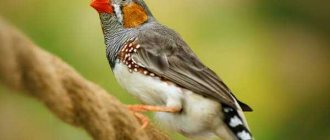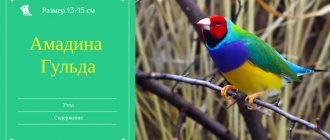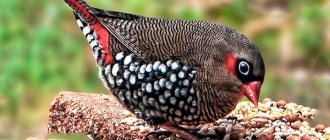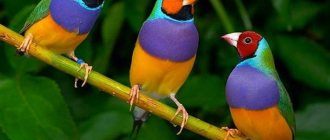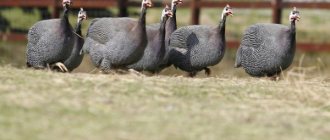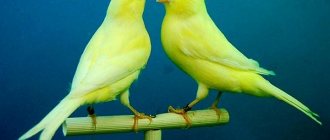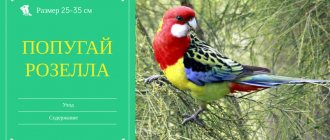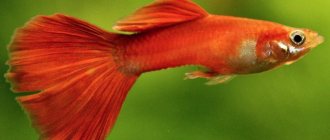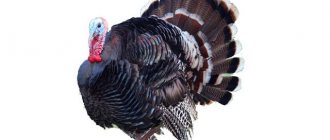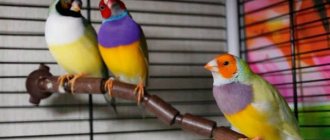The cheerful and funny finch bird is a welcome guest for those who love sonorous singing. Keeping finches does not require large financial investments or physical effort. Thanks to such unpretentiousness, combined with a peaceful character, bright songbirds have gained wide popularity. Before you bring a small feathered resident into your home, you need to find out what conditions he needs. How to prepare a room and arrange a cage, what to feed and what to do if you are sick. In addition to the basics of proper care, you should figure out whether it is possible to breed finches at home.
Red-headed Parrot Finch
Description
Finches belong to the family of weaver finches, the order of passeriformes. In nature, their habitat occupies three continents: individuals of different species are found in Africa, Australia, and South Asia. These birds are very elegant - their size does not exceed 15 cm, and their body weight is 50 g. They have a thick, triangular-shaped beak, translucent, as if cast from wax. The beak color is coral for males, orange for females, black for chicks.
The plumage palette includes a variety of shades: pastel colors in birds from temperate latitudes, bright color spots on the body of those who live in the tropics. Some finches are characterized by seasonal color changes. By the beginning of the mating season, males update their outfit, and upon completion of nesting they return to their normal color scheme.
This is interesting! Finches are considered songbirds, but their singing cannot be called outstanding. The sounds they make are more like a duck's quack.
Buy a bird
The birds communicate with each other quite interestingly, which deserves special attention. Therefore, you should only buy these birds in pairs, since one finch feels completely uncomfortable in the cage, sometimes making terrible sounds. Therefore, you should always remember this and should not mock these birds. If you keep finches at home, then only a couple, at least.
Each variety of these birds is considered rare, since there are not so many of them in natural conditions. Despite this, decorative finches are very popular because these birds are smart and give joy.
Birds cost depending on the species. In the markets, these birds cost at least 2 thousand rubles. Parrot finch and diamond finch will cost around 5 thousand rubles. If you buy them at a pet store, they will cost 3 thousand rubles. Japanese finches are much cheaper, so you can pay only 500 rubles for one bird. If you buy in pairs, then for Japanese or zebra finches you will have to pay 800 rubles each.
Popular types
Scientists count 38 species and 300 subspecies of finches. Of particular interest are those varieties that can be kept at home. Among these amazing birds, several prominent representatives of the breed stand out:
- Zebra finch. The head and neck are ash-colored, the back is brown, and the belly is light yellow. The area from the beak to the crop is painted with transverse black stripes. The tail is black with white spots. There are brick red triangles on the cheeks.
Zebra finches - Japanese finch. It was bred artificially from crossing the bronze manakan with the Chinese species of finch. The appearance is unprepossessing, but the character is balanced. Females incubate other people's eggs along with their own and are the most caring towards the chicks.
Japanese finches - Amadina Gulda. The bird is named after the wife of naturalist John Gould, who accompanied him on all expeditions. This species of finches has gained popularity due to its interesting coloring: uniform, rich shades, different in parts of the body, clear boundaries. Males sing well.
Finches Gulda - Tricolor Parrot Finches. The face mask is blue, the back and abdomen are grass-colored. The tail is crimson. The beak is dark, thickened, sharp. In captivity they are very shy, so they are kept in pairs. Aviary placement is also possible, in the vicinity of other songbirds.
Parrot finch
Story
The first Japanese finches were brought to Europe by smugglers, and these were snow-white birds, and not the ones they keep now - different shades of gray and red. The variety of colors in the photo is amazing.
It’s just that in Japan, all colors except boiling white were mercilessly rejected, but Europeans turned out to be “tolerant” of colors, and when breeding birds, color variants were acceptable.
Probably, the fact of domestic breeding for many centuries has formed a bird that is loyal to its fellow neighbors, is not picky in care, and does not need to be often let out to fly.
Maintenance and care
You need to understand that finches are very small and fragile birds. They should live in a cage and not jump freely around the room. Keeping feathered babies behind bars is not cruelty, but humanism, a method of protection from surrounding dangers. To keep songbirds at home, not much is required: purchase the necessary equipment, prepare a place, choose the right food.
Feeding
The diet of finches is quite simple, it does not involve any frills. It is based on a grain mixture with a predominant content of millet. Dry food also contains other components:
- hemp;
- canary seed;
- crushed oats;
- rape;
- flax and meadow grass seeds.
In addition to grain, parrot finches love raw vegetables, herbs, and berries - this is a tasty food for them, rich in vitamins. You can diversify your diet with dandelion, nettle, and plantain leaves. The exception is aromatic seasoning: dill, onion, basil.
Feeding finches only with plant products is not enough. Low-fat cottage cheese and a boiled egg are added to the daily intake of assorted grains twice a week. Food of animal origin contains calcium, phosphorus and other macroelements necessary for feather growth. The nesting period is characterized by increased energy consumption, which can be replenished with live food: mealworms, bloodworms, insects.
Attention! For proper digestion, finches require solid particles: sand, small pebbles, shell rock. Mineral feeding in the form of a special stone is a good remedy against beak deformation.
Light mode
Lighting means a lot to finches. They are harmed by both insufficient sunlight and poor lighting conditions. For breeding at home, a daylight period of at least 13 hours is required. Excessive daylight has a bad effect on the well-being of birds; bright lamps in the evening make them depressed. Lack of ultraviolet radiation is fraught with the development of rickets and metabolic disorders.
With the onset of the warm season, the cage is taken out onto the balcony or veranda, leaving it under the sun for several hours. On one side of the cage they create shade where the birds can hide. In winter, finches need an additional light source - an incandescent lamp or an ultraviolet lamp. It is preferable to use special lamps for birds, placing them no closer than one and a half meters.
Cage and accessories
The choice of cage depends on the planned number of wards. Most often, parrot finches live in groups at home, because they need company. If one pet is comfortable with a compact structure measuring 20/25/25 cm, then two or more birds will be comfortable with a spacious home. The optimal parameters for length and width are 40 by 60 cm, and the owners select the height taking into account the capabilities of the room.
The simpler the cage design, the easier it is to care for: wash, clean, change equipment. The materials from which the bird housing is made must be durable, safe, and hygienic. Finches do not tend to chew on rods, so combined housing made of metal and plastic or wood is not excluded for keeping them.
The cage is equipped with accessories:
- 2 plexiglass feeders;
- automatic drinker;
- 2 crossbars with a diameter of 9 mm;
- protective screen at the bottom along the entire perimeter.
Installing transparent protection solves the problem of debris spilling. In addition, the cage must have a tray with a retractable system. It comes with paper towels to make daily cleaning easier.
Hygiene and bathing
Water treatments are an essential part of caring for finches. But bathing a bird does not mean putting it in a bowl of water and soaping it up. The feathered pet needs to be given the opportunity to swim: install a special bathing suit - hanging or floor-standing, pour water into it so that the depth is no more than 1.5 cm. The device remains in the cage while the finches are actively splashing.
Amadin in a bathing suit
Parrot finches enjoy bathing. This is both entertainment and a way for them to care for their plumage. When in contact with water, the feathers are moistened and impurities are washed off. Water play is especially important during molting and when feather pests are present. Moisture relieves skin itching, promotes exfoliation of the epidermis, and normalizes the general well-being of birds.
Attention! Hygiene procedures are necessary for finches, but the water tank itself must be clean. After bathing, the container is rinsed well to prevent the formation of a mucous coating, dried and put away until next use.
Care during shedding
Finches molt twice a year, and this is a natural process, but it makes the birds uncomfortable. In females, molting usually occurs at the end of the breeding season. When changing plumage, finches are weakened and need increased attention. Moulting birds are subject to frequent mood swings, their appetite deteriorates, and males temporarily stop singing. To help pets cope with apathy, you need to restore their sense of comfort. To do this, a set of measures should be taken:
- ensure daylight hours of at least 10 hours;
- increase the room temperature to 26 - 28 degrees;
- maintain relative air humidity of 60%;
- allow bathing daily;
- add Tsamax to the feed according to the instructions;
- monitor the constant presence of mineral components in the cell.
Feather loss does not always occur as normal. Sometimes shedding occurs due to stress or illness. It is difficult to get rid of such a pathology; it can drag on indefinitely and even lead to the death of the finch.
What to feed
Not everyone’s food is suitable for the “Japanese”! Under no circumstances do we provide food for parrots or simply for small and medium-sized birds; we need a mixture for exotic birds from a well-known manufacturer of bird food.
We carefully read the composition of the purchased food, it should be something like this: for 10 parts of millet (yellow) - 1 part rapeseed, 1 part or a little more oatmeal, 3 parts canary seed, preferably 1 part each of hemp and chumise seeds, also part of meadow wild grasses (for example, plantain, clover or dandelion). A teaspoon of dry mixture per bird is enough.
You need to feed a variety of foods! In addition to dry food, Japanese finches will happily eat porridge, including buckwheat, millet or rice.
Chopped green (fresh, not limp) lettuce leaves, dandelion and plantain leaves - this is what Japanese finches love and this is also extremely useful for them to give.
We give pieces of fruit without restrictions, but remove uneaten remains in a timely manner. Birds will also eat a hard-boiled egg with pleasure, and sprouted grains are both healthy and loved. But these supplements must be given without fanaticism.
Diseases and prevention
Fragile finches are susceptible to specific diseases that are common to all birds. Among the characteristic avian diseases, psittacosis, internal tumors, and parasites are especially dangerous. Parrot finches also suffer from damage to the beak and feathers; They often have indigestion. Vitamin deficiency, baldness, injuries and poisoning are common phenomena in small birds, depending on the conditions of detention. To prevent complications, you should take care of your pets.
The biggest concern for owners is contagious diseases. Pet finches can pick up infections, mites, or fungi from new ones purchased at a pet store. Typical signs of a viral infection: changes in behavior, drowsiness, refusal to eat. But these same symptoms can be a manifestation of any other disease. If there is a suspicion that the pet is unwell, it is shown to the veterinarian. Reducing the likelihood of infection is easier than treating it, so quarantine is necessary for feathered newcomers.
Price
The cost of the Japanese finch depends on the place of purchase:
- at the poultry market you can buy a chick for 200 rubles;
- private advertisements contain information about the price of 500-900 rubles per individual;
- nurseries offer ringed, healthy birds at prices starting from 1000 rubles.
The most affordable way to buy finches is at a pet store. Professional breeders cooperate with online stores and successfully sell birds on pre-orders.
Breeding at home
By analogy with budgies, finches easily reproduce in captivity. Their sexual instinct first appears at the age of 7–9 months. Breeders agree that early breeding should not be encouraged - let the female grow up to at least a year. If the owner is interested in obtaining offspring from his charges, he must place a couple of birds in a separate cage in time. In a new home, you should hang a nesting house and provide the pets with material for building a nest: twigs, hay, dust. In one year, finches have up to three broods, but if they nest so often, the female’s body may not be able to withstand it. Sometimes tired birds abandon their chicks or die from exhaustion.
Taking care of your health
It is very important for a novice owner to become familiar with the description of the main diseases of finches, as well as treatment and prevention measures. The most important symptoms: loss of appetite, passivity, feather loss. However, if this is observed at the age of 1.6-3 months, then it is possible that the bird is experiencing its first moult. During this period, the diet is enriched with sprouted grains, vitamins and minerals.
Infectious diseases are fungal, parasitic and bacterial. A sick finch begins to hide its head under its wing, refuses food, but drinks a lot. The bird is placed in a quarantine cage, shown to a veterinarian and his recommendations are followed.
The main non-contagious disease is baldness (alopecia), associated with poor living conditions and iodine deficiency in the diet.
Note! Avocado, persimmon, green onions, dill are the cause of gastrointestinal diseases in birds. Feeding finches with these products is strictly prohibited.
Caring for chicks
After mating games, the female sits in the nest and lays 2–5 white eggs. She warms the clutch during the day alternately with the male; at night the finches sit together on the eggs. After 12 - 16 days, the chicks appear, naked, blind and helpless. The parents feed them partially digested food, which is regurgitated from the crop into the beaks of the young. On the third day, the chicks begin to develop fluff, the first sounds appear - a voice emerges.
The features of caring for finches chicks do not differ from those required for any birds. The young begin to fly after three weeks and try to fly out of the nest. At this time, the brood must be diligently monitored and returned to its parents after a fall. It is recommended to secure several thin perches near the nest, on which the chicks will learn to jump and take off. It is possible that by the time the young birds are placed in another cage, the female will begin nesting again.
Exotic birds, finches, are capable of delighting people with just their appearance. And if they start singing and taking food from their hands, no one remains indifferent. You shouldn’t expect the same emotional response from these birds as from parrots, but the serene twitter of finches creates a very cozy atmosphere in the house.
Supplements
Finches should have minerals in their daily diet. Any sand (even sea sand), well washed, eggshells, white chalk for birds, finely ground shells - this is the kit so that the “Japanese” do not lack minerals.
If it is difficult to constantly monitor such a complex composition of natural mineral supplements, then bird food manufacturers produce universal mineral supplements, but you must carefully observe the daily dose.
Fighting excess weight
A common problem with domestic finches is excess weight. Birds quickly gain it when they have poor diet or little activity. You can combat this problem with diet. Remove foods containing large amounts of protein and fat from your diet for a couple of weeks.
If possible, move the birds to a larger cage, but it will be better if they can fly around the room.
How to tame?
To tame a finch who is not afraid of a person and sits freely on his hand, there are several rules:
- The owner should only tame his bird alone with it. If a person has several finches, the friends can be temporarily moved to another enclosure or cage. “Lessons” must take place daily. This is the only way the finch can fully get used to human hands.
- Immediately after purchase, veterinarians advise clipping the birds’ wings. This way they won’t fly out the window, and the owner won’t catch the finch around the room.
- For each correctly completed “lesson,” it is recommended to reward the bird with some kind of treat. For example, grains or berries.
- In order for the finch to start jumping onto a person’s hand, it must be driven into the corner of the cage - into a trap. The bird will most likely jump on your hand.
- Training can last from several weeks to several months. The main thing is that the finch is young. This will be easier to train.
After the finch has learned to jump on a person’s hand and is no longer afraid of its owner, it can sometimes be released to fly around the room, but be sure to keep an eye on the bird and close the windows and doors tightly.
